News about Tucson Water’s plans to treat sewage effluent to drinking quality coincided this week with national headlines: New research finds much treated wastewater across the U.S. is contaminated with “forever chemicals.”
Tucson just signed an agreement with the federal government to get $86.7 million to build a plant to treat sewage effluent to drinking quality.
In part, that’s intended to serve an area on the metro area’s northwest side whose wells have been closed due to contamination by the PFAS compounds known as forever chemicals.
The utility says the recycled water the plant will treat starting in the early 2030s has already been treated at the Pima County-run Tres Rios wastewater plant and will get further “purification” to make it drinkable.
But records show the partially treated wastewater contains PFAS compounds that may have to be removed themselves, before the fully treated water is served to the public.

Pima County’s Tres Rios Wastewater Reclamation Facility.
While it’s far too early to say how the utility will deal with the PFAS, an outside expert and a new study in another state indicate the price tag would be very high.
The planned Tucson facility would convert about 2.5 million gallons a day of treated wastewater into drinkable water, though a process called advanced water purification. The 2.5 million gallons represent between 2% and 5% of the city’s total drinking water supply, Tucson Water Director John Kmiec has said.
Tucson is hardly alone with having to deal with PFAS in its treated sewage effluent. Two studies, one released Monday, showed in different ways that PFAS compounds are regularly present in municipal wastewater around the country.
One of the studies, done for the National Academy of Sciences, found that wastewater contaminated with PFAS had found its way into drinking water systems all over the country serving up to 23 million people.
The other study, done for Minnesota’s state Water Pollution Control Agency, found that the cost of removing all PFAS from the state’s wastewater and then destroying the PFAS so it couldn’t pollute anywhere else was so high, it could spike homeowners’ monthly sewer bills by up to 10 times.
“Without an alternative source of funding, PFAS removal and destruction from municipal wastewater will be unaffordable for the foreseeable future” in Minnesota, the agency concluded.
Tucson Water officials, asked how they would deal with PFAS found in Pima County’s treated wastewater, said in an email that over the next few years, they will work with the Pima County Regional Wastewater Reclamation Department to gather “all wastewater and recycled water quality information,” in line with new state regulations.
Arizona’s regulations, approved last year, allow local governments to begin “direct potable reuse” of treated effluent for drinking.
“The final treatment process will not be established for some time, so we cannot provide operational costs or data at this time,” Tucson Water said.
Tucson Water told the Arizona Daily Star its goal for the future “advanced water purification” program is to produce water that not only meets and exceeds government drinking water standards but includes a “multi-barrier treatment approach” that would address unregulated compounds as well.
And Pima County’s deputy wastewater director, Jeff Prevatt, told the Star he is “extremely confident” Tucson Water will be able to produce “high purity, PFAS free water.”
Tucson can’t afford it, Kozachik says
A California scientist and wastewater expert said this “is going to be one of the most expensive options” that exists for providing alternative water sources.
“It can be done. The PFAS and the cost is not a reason not to do it,” Arturo Keller, a professor at the University of California’s Bren School of Environmental Science and Management, told the Arizona Daily Star. “It’s generally thought membrane technologies for it such as reverse osmosis can treat and remove it. But they need to monitor it constantly to make sure there isn’t any breakthrough of the PFAS (into the environment).”
“The whole treatment train is very energy intensive,” using membranes, ozone and reverse osmosis, adding to the cost of the system, Keller said, though proponents say it will be far less expensive than desalinating seawater and shipping it from the Pacific Ocean or the Gulf of California to Arizona.
Former Tucson City Councilman Steve Kozachik, who was the first local official to publicly raise concerns about PFAS contamination of groundwater, told the Star he doesn’t believe the city will be able to afford large-scale treatment of effluent to drinking water quality.
“There is no way they can afford the financial costs of pulling PFAS and other emergent pollutants out of wastewater,” Kozachik said Friday. “The city cannot afford toilet to tap with these remediation costs built in. And the Department of Defense certainly is not going to pay billions at wastewater treatment plants all over the country.” (Military bases in Tucson are under investigation for letting PFAS compounds previously used in firefighting foam contaminate groundwater.)
Tucson’s goal: large-scale treatment
A dozen PFAS compounds have been found in the effluent departing the Tres Rios plant for the Santa Cruz River since 2022, records from Pima County Wastewater Reclamation Department show.
Only one of those compounds was at high enough concentrations to exceed the recently installed federal drinking water standards for PFAS compounds. But only four of those compounds even have federal drinking water standards, as approved last spring by the U.S. Environmental Protection Agency.
Environmentalists, outside scientists and various industry officials are currently locked in a debate over whether the current standards are adequate, not strict enough or too strict.

Wastewater reclamation basins at Pima County's Tres Rios plant.
While 2% to 5% of Tucson’s supply may not seem like a lot of water, Kmiec and other city officials have made it clear that if a small plant like this one works out well, it could serve as a pilot project for a much bigger plant in the future. That’s if one is needed to augment the city’s highly vulnerable groundwater and Colorado River supplies.
The One Water plan that the Tucson City Council approved about a year ago calls for large-scale treatment of sewage effluent for drinking in a high-tech plant, but contains no timetable for when such a plant would be built.
In addition, many other Southwestern cities, including Phoenix, Los Angeles and San Diego, are looking closely at building similar plants to treat their own sewage effluent to drinking quality. They, like Tucson, face a future of less water from their current sources due to over-pumping of groundwater, drought and climate change.

An engineer fills a container with recycled water at the Advanced Water Purification Facility in San Diego, a pilot project that treats effluent to drinking water standards.
Study’s release overlaps with vote
But the two studies, one new and one two years old, suggest that PFAS is a common contaminant in wastewater that is expensive to remove.
The newest study, prepared by scientists for the Proceedings of the National Academy of Scientists, was released Monday.
That was the day before the Tucson City Council unanimously voted to strike an agreement with the U.S. Bureau of Reclamation to leave behind more than one-third of its annual Colorado River supply in Lake Mead over a decade in exchange for getting the $86.7 million to build the treatment plant.
The new study found elevated levels of all six regulated PFAS compounds in wastewater samples taken nationally. It looked at effluent from eight large treatment plants around the country whose treatment technologies are heavily used.
That study found that PFAS was, however, only a small percentage, probably less than 10%, of all the “organofluorine” compounds typically found in wastewater. Most of the orgnoafluorines are commonly prescribed pharmaceuticals, while others are extensively used in modern commerce for refrigeration, agrochemicals, nonstick and greaseproof coatings and fluoropolymers. They are a family of high-density plastics used in industries, including aerospace, automotive, electronics, and medical applications.
Generally, conventional wastewater treatment doesn’t do a good job of removing such compounds including PFAS, operating at less than 25% efficiency, the study said.
“The rule in general is that smaller molecules (in these compounds) are more likely to get through the membrane pores, while larger ones will be removed, regardless of whether they have fluorine or not. It is likely that some of the pharmaceuticals that have fluorine are small enough to sometimes pass through,” said Keller of the University of California at Santa Barbara.
Ironically, what’s known as “short-chain” PFAS compounds, which in recent years have been seen as more environmentally benign replacements for traditional “long-chain” PFAS compounds, are more difficult to treat than their long-chain counterparts, he said.
“Short-chain PFAS are smaller molecules, so there is higher likelihood of passing through the membrane” in a treatment plant,” he said. “Although initially there was the thought that short-chain PFAS compounds were more benign alternatives, some new studies are showing concern even with these replacements. However, the additional treatment is likely to remove the residual short-chain PFAS compounds,” he said of the use of more sophisticated plants for treating wastewater to drink.”
This study looked at the impacts of contaminated wastewater at a different step in the process compared to what Tucson Water and other utilities are considering or planning to treat for drinking. The new study showed how much wastewater going downstream in rivers after being treated in sewage plants is inadvertently contaminating other drinking supplies.
A 2023 study coming out of Minnesota’s Water Pollution Control Agency, meanwhile, estimated the high costs of removing all PFAS from all the wastewater kept in all the state’s 283 municipal sewage treatment plants.
The study examined costs of first removing leaves and brush and other organic matter from the wastewater so the membranes used to remove the PFAS would work and then of actually removing the PFAS. Finally, it looked at the costs of destroying the PFAS by breaking it down into its elemental compounds, typically carbon and fluorine. Put together, removing and destroying the PFAS cost a range of $14 billion to $28 billion.
For the individual Minnesota homeowner, a massive sewage treatment project of that nature, conducted statewide, would raise the typical Minnesota homeowner’s sewer bill from a current range of $30 to $49 a month to $300 to $400 a month, said Scott Kyser, a Minnesota Pollution Control Agency environmental engineer.
That’s even though the PFAS concentrations in the wastewater are generally, typically in the range of “single digit” parts per trillion, Kyser said.
“Broadly speaking, the concentrations are similar to those in every other state; single digit part per trillion,” he said. “That’s part of the reason why it’s so expensive. The concentrations are so low, it’s hard to treat.”
Tucson plans to exceed standards
Tucson Water told the Star its goal for the future “advanced water purification” program is to produce water that not only meets and exceeds government drinking water standards but includes a “multi-barrier treatment approach” that would address unregulated compounds as well.
“These multi-barrier treatment processes will target a wide list of organic and inorganic chemical compounds, as well as microbiological impurities,” the utility said.
Tucson Water’s own internal operating standards for the quality of water it serves “have historically been more conservative than the EPA in regard to PFAS compounds,” the utility told the Star.
Separately, the Pima County Regional Wastewater Reclamation Department will begin a pilot project that will be the nation’s first “real-world demonstration” of a PFAS reduction technology for municipal wastewater, Prevatt, its deputy director, told the Star.
It will be conducted at the University of Arizona’s WEST Center, with various wastewater utilities from around the state participating, he said. The center, which develops new technologies dealing with water scarcity and reuse, lies near the county’s Aqua Nueva wastewater plant.
In the mid-2010s, the county department and Tucson Water joined to build and operate a pilot, advanced water treatment project to transform effluent from the Aqua Nueva plant and others in Phoenix and Flagstaff “into high purity drinking water,” Prevatt said.
“All of the results from that project demonstrated the complete removal of PFAS compounds. I am extremely confident the (future) advanced water treatment process developed by Tucson Water will achieve similar results, producing high purity, PFAS free water,” he said.





